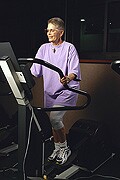- Skip Storing This Everyday Product in the Fridge Door
- Green Tea + B3 Pairing May Boost Brain Health
- Navigating Your Midlife Crisis: Embracing New Possibilities
- City Raccoons Showing Signs of Domestication
- Mapping the Exposome: Science Broadens Focus to Environmental Disease Triggers
- One Week Less on Social Media Linked to Better Mental Health
- Your Brain Changes in Stages as You Age, Study Finds
- Some Suicide Victims Show No Typical Warning Signs, Study Finds
- ByHeart Formula Faces Lawsuits After Babies Sickened With Botulism
- Switch to Vegan Diet Could Cut Your Greenhouse Gas Emissions in Half
Exercise May Buffer Symptoms of Early Alzheimer’s


Regular exercise may be the best medicine for seniors facing the onset of dementia, according to three new clinical trials.
Physical activity improved mood, memory and ability to think for participants in all three studies.
One study found that intense aerobic exercise improves blood flow to key areas of the brain, and appears to reduce the tau protein tangles that are a hallmark of Alzheimer’s disease. Alzheimer’s is the most common form of dementia.
“Blood flow decreases in those areas for all of us with age, and yet exercise increased it,” said lead author Laura Baker, a cognitive neuroscientist at Wake Forest School of Medicine in Winston-Salem, N.C. “It seems to me we’re changing aging-related effects, and we may be changing Alzheimer’s-related effects, both with exercise.”
The new research was scheduled for presentation Thursday at the Alzheimer’s Association International Conference in Washington, D.C. Findings presented at meetings are usually considered preliminary until published in a peer-reviewed medical journal.
The three studies “give us information about living better with the disease,” said Heather Snyder, director of medical and scientific operations for the Alzheimer’s Association.
“Physical exercise is potentially beneficial to people who are living with Alzheimer’s today,” Snyder said. “Even once you have cognitive impairment, there’s still a benefit to physical activity.”
Prior research has shown that exercise can improve the ability to think in healthy adults, so Baker and her colleagues turned to people with mild impairment to see if physical activity would help them, too. The 65 people in Baker’s study were 55 to 89 years old and had not been exercising beforehand. They also had prediabetes, which can increase risk of developing Alzheimer’s disease.
Participants were randomly assigned to one of two groups for six months. The first group performed stretching exercises that did not raise their heart rate much, while the second group had to perform at least 45 minutes of high-intensity aerobics four times a week.
The aerobics group had to stay within 75 percent to 85 percent of their maximum heart rate for at least 30 minutes of their workout, which most often took place on a treadmill. “For our typical 70-year-old, that means a heart rate of at least 130 beats per minute,” Baker said.
Ninety-two percent of people stuck to the exercise program, and wound up with improved fitness and better blood sugar levels, researchers found.
More important, MRI brain scans revealed that blood flow had significantly increased to the memory and processing centers of participants’ brains, with a corresponding improvement in their ability to plan, organize and pay attention.
Tests using cerebrospinal fluid samples drawn from the patients also showed a significant reduction in tau protein tangles, with the effect most pronounced in those older than 70.
“These findings are important because they strongly suggest a potent lifestyle intervention such as aerobic exercise can impact Alzheimer’s-related changes in the brain,” Baker said. “No currently approved medication can rival these effects.”
In another clinical trial, 200 people between ages 50 and 90 with Alzheimer’s were randomly assigned to either an aerobic exercise program or a control group that performed no extra exercise. The folks who exercised were asked to reach a target intensity of 70 percent to 80 percent of their maximum heart rate.
The Danish researchers found that those who exercised suffered from fewer mood problems such as anxiety, irritability and depression. The people who exercised most often and most vigorously also achieved significant improvements in mental speed and attention.
The third clinical trial took place in Canada and involved 71 people between ages 56 and 96 who had suffered ministrokes, diminishing their ability to think and remember. Half were assigned to a group that took part in regular aerobics classes.
The researchers found that participants who took aerobics significantly improved their memory and selective attention, compared with those not asked to exercise regularly.
Snyder and Baker said most seniors should be able to find some physical activity they can perform, even if they have some age-related infirmities.
“You don’t have to use any one exercise,” Baker said. “It’s anything you can get your heart rate up to where you are panting and sweating.”
However, she noted that seniors should consult their doctor before embarking on an exercise program, and ease into it. The Danish study gave participants four weeks to adapt before asking them to exercise more intensely.
If someone already has dementia, they still can benefit from exercise, but will probably need someone to guide their workout schedule, Baker added.
“But that supervision can be in the form of group exercise,” she said. “It doesn’t have to be one-on-one.”
More information
For more on Alzheimer’s disease, visit the U.S. National Institutes of Health.
Source: HealthDay
Copyright © 2025 HealthDay. All rights reserved.










